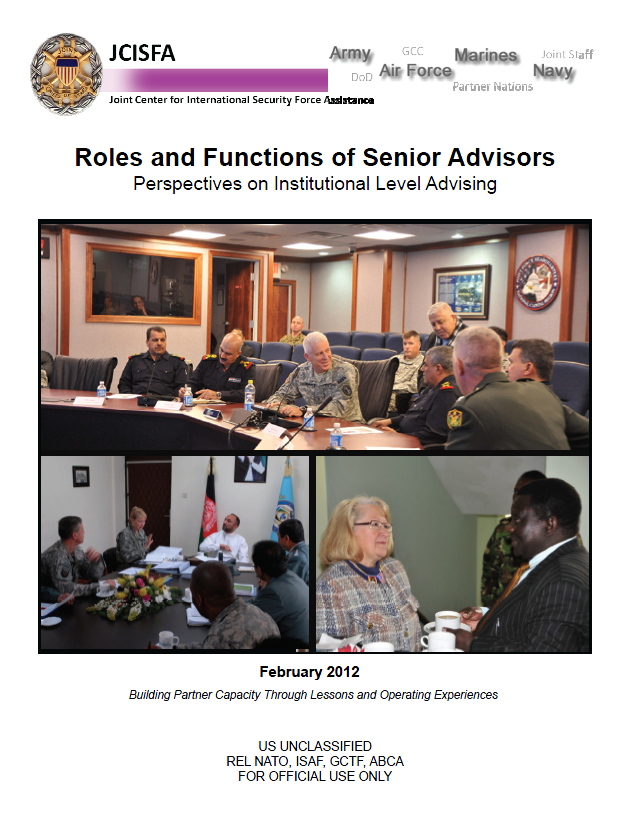Roles and Functions of Senior Advisors: Perspectives on Institutional Level Advising
- 70 pages
- For Official Use Only
- February 2012
a. When advising and assisting partner nation security ministries and their institutions, the U.S. Department of Defense (DoD) leverages the knowledge, skills, and abilities (KSA) from a combination of senior uniformed and civilian personnel, to include contractors to carryout development in a broad range of partner nation ministries and institutional requirements. Once selected, these individuals must bring forward executive level talent and capacity to meet the developmental needs of partner nation [executive] counterparts.
b. The aim of this chapter is to go beyond anecdotal and academic suggestions of describing what a senior advisor is or is not. Its goal is to provide a direct correlation to what senior level advisors “must do” or the required capabilities, that senior advisors must have, in context to Security Force Assistance (SFA). Through lessons and analysis of current and projected operating environments, the concepts proposed herein offers a framework to support broader force-wide initiatives in the training and leader development of senior advisors. This chapter does the following:
– Describes Strategic Context and Implications for Senior Advisors
– Depicts the Senior Advisor Operating Environment (OE)
– Provides Emphasis on Roles and Functions of Senior Advisorsc. Senior advisor requirements for specific partner nations are beyond the scope of this chapter. However, as senior advisors carry out their specific roles and functions, their actions will occur within the context of a broader strategic and organizational context as it relates to the ministries they are advising and assisting.
1-2. Strategic Context and Implications
a. DoD Policy and Joint Force Training Emphasis
(1) Recent U.S. strategic guidance coupled with current policy requires DoD to develop and maintain capabilities within general purpose forces (GPF), special operations forces (SOF), and the civilian expeditionary workforce (CEW) to carryout SFA activities in support of U.S. policy and in coordination with U.S. government departments or agencies. In parallel, the Chairman of the Joint Chiefs of Staff (CJCS) emphasized that SFA is a key component of U.S. defense strategy against both traditional and increasingly irregular threats. In doing so, he added SFA to the joint force high interest training issues (HITI) list, stressing that joint force providers should identify individuals and organizations likely to conduct SFA and address training certifications, language skills, regional expertise, and cultural awareness for those personnel and organizations.
b. DoD Concepts and Strategic Planning Implications
(a) In addition, policy and training emphasis captures DoD’s transition from a contingency-centric to a strategy-centric approach, provided through its Guidance for Employment of the Force (GEF). This strategic document seeks an end-state, through security cooperation (SC) activities to enable partner nations to provide for their own security, contribute effectively to broader regional or global security challenges, and maintain professional, civilian-led militaries that respect human rights.
(b) In practice, SFA activities support concepts such as building partner capacity and extend U.S. capabilities and capacity within Security Cooperation (SC) and Security Assistance (SA) programs and activities. DoD policy mandates that SFA serve as a subset of overall DoD level SC initiatives. In support of this requirement, the U.S. Army, for example, recently approved its conceptual framework for building partner capacity and identified SFA as a required capability or operational action that it must perform to carry out this framework. 5 As such, there are four core strategic planning focus areas, contained within the GEF, that drive DoD security cooperation – and in effect, SFA strategic planning, they include:
– Focus on providing the necessary training and equipment required to improve the performance of partner military forces (Operational Capacity and Capability Building)
– Focus on developing partner country military and civilian security officials and the human capacity they require to sustain their defense sector over time (Human Capacity and Human Capital Development)
– Focus on security institutions of partner countries and the development of the necessary systems and processes to sustain operational and tactical capacities and human capital over time. (Institutional Capacity and Security Sector Reform)
– Focus on a partner’s ability to operate effectively alongside or in lieu of U.S. forces in a coalition or formal alliance (Combined Operations Capacity, Interoperability, and Standardization)

